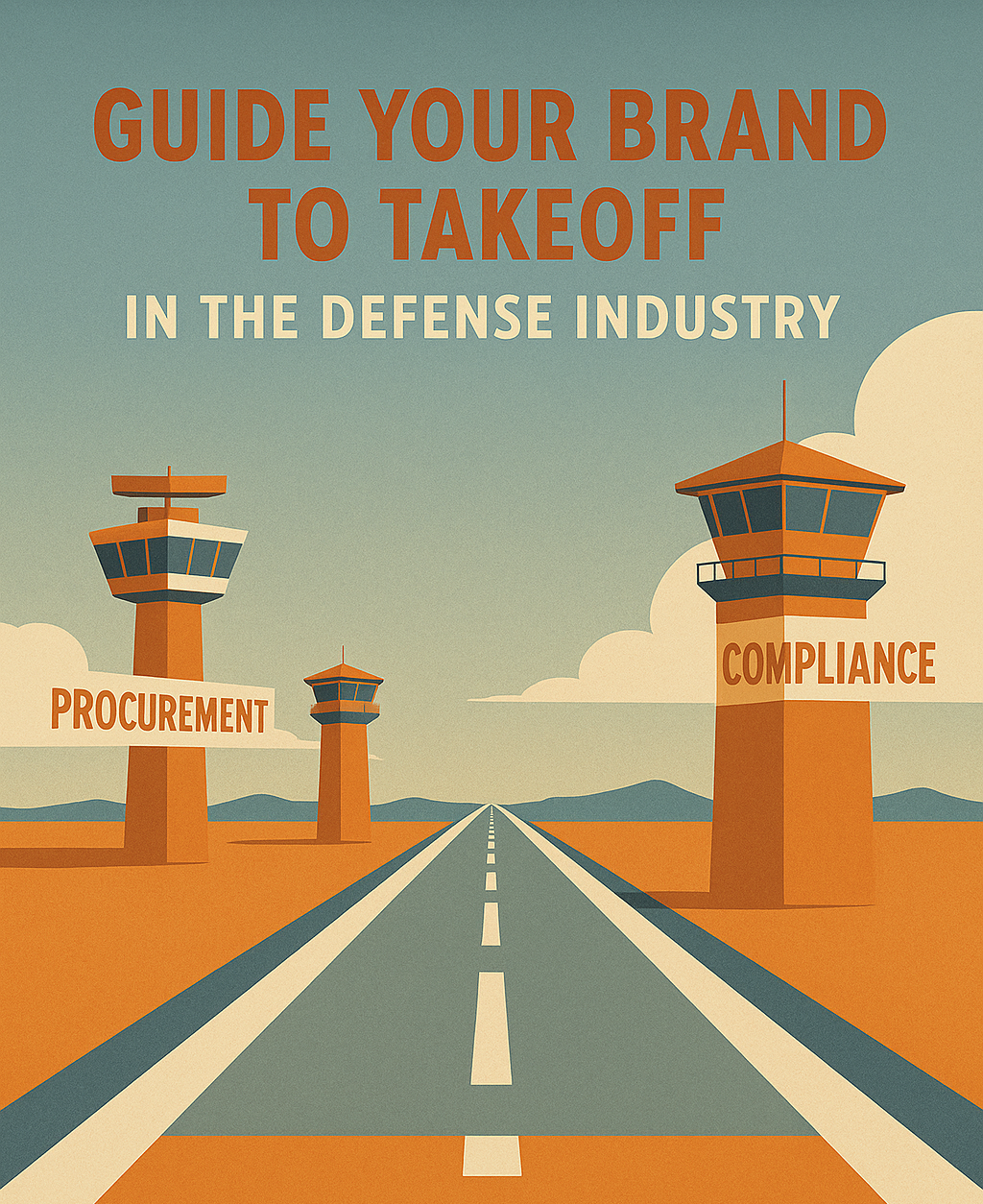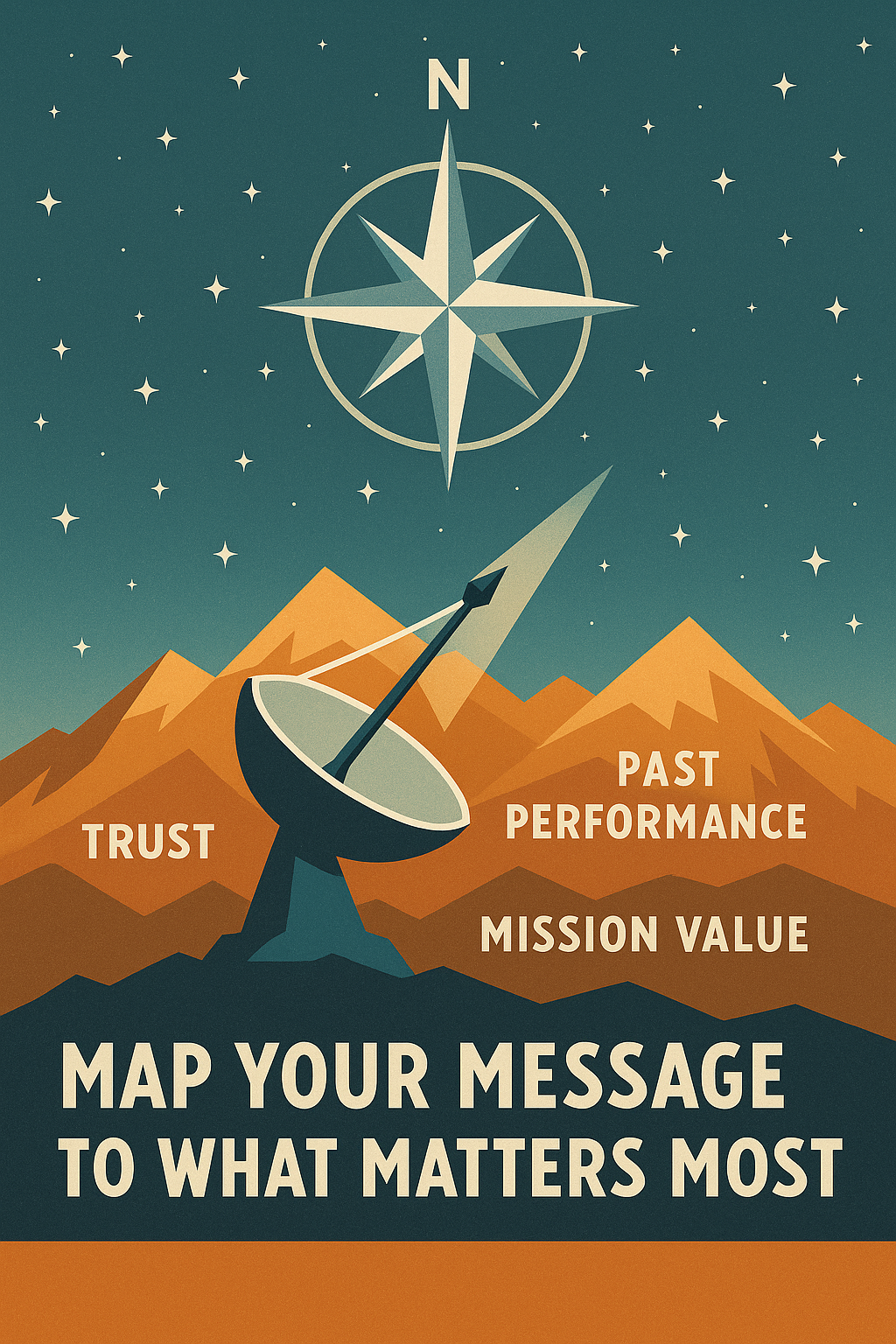You’ve got a cutting-edge aerospace or defense tech business idea.
But here’s the catch: no one’s biting—and it’s not because your innovation isn’t extraordinary.
It’s because your brand doesn’t cut through the noise.
In the world of defense and aerospace, credibility, clarity, and strategic visibility matter more than ever.
You might have the tech to outpace adversaries or disrupt defense procurement—but if your brand strategy is stuck in 1995, even your best innovations will die on the vine.
The truth is, in this highly regulated, fiercely competitive, and procurement-driven sector, your brand needs more than a logo and a trade show booth.
It needs to resonate with program officers, contracting authorities, prime contractors, and battlefield decision-makers alike.
That’s where this playbook comes in.
I’m Viktor Ilijev— tactician, pitch strategist, and novice fly fisherman. I’ve spent 13+ years helping B2B companies build millions in deals, funding, and contracts by aligning their message with market demand.
In this guide, I’ll show you how to craft a B2B brand strategy for aerospace and defense (A&D) tech that borrows from the best in the commercial sector—companies that’ve mastered digital presence, emotional resonance, and conversion-driven storytelling.
Understanding the Defense Tech Brand Landscape
Branding in the aerospace and defense industry is uniquely complex.
Unlike commercial markets, where agility and buzz can create overnight success, defense tech companies operate in a highly regulated, slow-moving, and trust-dependent ecosystem.
Here’s what makes building a B2B brand in this space so challenging:
Government Contractor Constraints: Strict compliance regulations, export controls, and information security protocols limit what a marketing agency can do creatively. Traditional marketing services—like viral campaigns or influencer content—often aren’t viable in this space. As a result, many defense contractors default to outdated branding practices that fail to differentiate or resonate with today’s key decision-makers.
Long Procurement Cycles: From RFI to RFP to award, defense procurement processes can stretch across years. A weak brand—one without staying power or strategic clarity—will fade from memory long before contracts are won. To grow your business, you need a brand strategy designed to survive and thrive through multi-year evaluation cycles.
Risk-Averse Stakeholders: Decision-makers in the defense industry aren’t moved by trendiness. They’re looking for stability, security, and a proven track record. A flashy message that works for a startup in commercial SaaS won’t cut it with procurement officers or military end users. Your brand must instill confidence, backed by measurable results and aligned to mission-critical needs.
Lack of Differentiation: Many technology companies in A&D sound the same—“cutting-edge,” “mission-driven,” “trusted partner.” Without a strategic approach to messaging and visual identity, you risk becoming indistinguishable in a crowded, competitive market. A strong branding agency helps tease out your unique strengths, turning technical capability into compelling positioning.
In short, branding for defense and aerospace isn’t just about design—it’s about positioning, proof, and persistence. You need a comprehensive approach that accounts for the entire procurement lifecycle, cultural nuances within the military-industrial complex, and the long-term relationships that define success in the sector.
How Procurement and Policy Shape Brand Strategy
If you want to win in defense, you must align your brand strategy with the realities of the procurement ecosystem. Here’s how procurement shapes brand behavior:
Navigating Defense Procurement and Compliance: Procurement in the defense and aerospace sector isn’t about who shouts the loudest—it’s about who checks the most boxes. Every element of your online visibility—from your website development to downloadable corporate capabilities brochures—must reflect your readiness to meet complex government contractor requirements. That means compliance-forward copy, proper documentation, and marketing communications that respect the boundaries of classified work and ITAR/EAR regulations.
Importance of Trust, Credibility, and Past Performance: In this world, past success is your strongest differentiator. Brands that showcase a proven track record, articulate results-driven case studies, and highlight innovative solutions relevant to current industry challenges are more likely to win over skeptical evaluators. Your digital branding must effectively communicate these outcomes—not just with text, but through structured storytelling, visual elements, and endorsements that resonate with high-level procurement stakeholders.
Ultimately, your B2B branding must do more than “look good.” It must strategically position your business to win contracts, build trust with key decision-makers, and stand up to the scrutiny of multi-tiered evaluation processes. When you navigate the complexities of defense procurement with strategic clarity, your brand becomes a force multiplier—transforming technical brilliance into business growth.
Lessons from Commercial B2B Brands
In the defense and aerospace space, the term “digital branding” often still means a static PDF and a LinkedIn profile with minimal engagement.
But to grow your business in a procurement-heavy, reputation-first sector, you need to start thinking like a high-growth tech startup—especially in how you present your brand online.
Top technology companies in the commercial world treat their digital assets as their storefront, pitch deck, and proof of credibility.
The lesson?
Trade shows, while still valuable, can’t be your only branding battlefield.
Your digital ecosystem—website development, SEO, case studies, explainer videos, and social engagement—must be strategically designed to work even when you’re not in the room.
A forward-thinking marketing agency helps defense contractors elevate their digital visibility through:
Search engine optimization (so your brand ranks where your buyers are looking)
Purpose-built landing pages for capabilities and services
Conversion-focused site structure aligned with procurement journeys
Compelling content that resonates with both technical evaluators and non-technical stakeholders
Digital branding is no longer a luxury—it’s your first impression. In a competitive market where perception equals access, a digitally fluent brand becomes a signal of operational maturity and readiness.
The Role of Corporate Capabilities Brochures and Storytelling
The corporate capabilities brochure has long been a staple in A&D. But too often, it’s a jargon-heavy, uninspiring document. In contrast, commercial b2b brands have transformed their product and service collateral into interactive, story-driven assets that effectively communicate value, vision, and differentiation.
Your capabilities document should:
Tell a strategic story—who you serve, what challenges you solve, and the proven results you’ve delivered
Align with your brand’s visual identity and tone across all marketing communications
Integrate rich media like video snippets, testimonials, and animations to boost engagement
Be optimized for digital delivery—mobile-friendly, trackable, and easy to update as your offerings evolve
Think of it not just as a compliance box, but a brand asset. A smartly crafted brochure can help defense contractors shift from transactional to transformational storytelling—turning dry capabilities into a strategy that aligns with buyer needs and stands out from competitors.
Leveraging Social Currency and Triggers
Commercial brands thrive on virality. While aerospace and defense can’t go viral in the traditional sense, Jonah Berger’s framework in Contagious reveals principles that can be powerfully adapted to b2b branding: social currency, visibility, and emotional triggers.
Here’s how you apply it in a highly regulated space:
Social Currency: Position your products and services as thought-leading and mission-critical. Use success metrics and forward-looking insights to make stakeholders feel smart for sharing your content.
Visibility Triggers: Regularly publish content timed around industry trends, procurement cycles, or major industry events. Use social proof—like endorsements from industry leaders or high-profile partners—to legitimize your brand.
Emotion and Storytelling: Highlight real-world impact. Show how your tech helps “keep warfighters safe” or “accelerates mission success”—language that resonates emotionally and aligns with the values of your target audience.
The key is building a brand that people in the space talk about, trust, and remember—especially when it’s time to make procurement decisions.

Strategy Framework: Build, Align, Amplify
To win in the defense and aerospace sector, your b2b brand needs to do more than look credible—it must communicate value clearly, navigate procurement complexity, and scale across multiple touchpoints. This three-part framework ensures your brand is not only defense-ready but built for sustained impact in a competitive market.
Build a Defense-Ready Brand Core
Before you launch any campaign, your brand must be grounded in strategic clarity. This begins with answering three foundational questions: Who are we? What do we stand for? Why do we matter—right now?
A defense-ready brand core must:
Clarify the brand’s essence, mission, and value proposition: Define not just what your company does, but why it exists. Your value proposition should go beyond technical specs—speak to mission alignment, resilience, and reliability. Think like a strategist: how does your offering help defense agencies achieve operational success or modernization goals?
Align with evolving needs of government and military stakeholders: A brand is not static. It must adapt to industry trends, shifting mission priorities, and geopolitical realities. Position your brand as responsive—not just to today’s needs, but to tomorrow’s challenges.
This foundation is what enables technology companies in A&D to grow your business with focus and credibility. A smart marketing agency ensures these brand elements cascade through every visual, verbal, and strategic layer of your presence.
Align Brand With Go-To-Market & Procurement Strategy
B2B branding in this space fails when it’s siloed. To succeed, your brand strategy must be integrated across marketing efforts, business development, and procurement operations.
Bridge marketing, sales, and capture teams: Your marketing services should operate in lockstep with the capture and proposal teams, aligning around target contracts, priority programs, and agency missions. This synergy reduces friction and ensures your brand message reinforces deal pursuits—not distracts from them.
Ensure tailored messaging by audience: One message doesn’t fit all. Contracting officers care about risk, compliance, and pricing. End users care about functionality, mission impact, and UX. Influencers care about modernization, innovation, and long-term capability. Your messaging must be strategies tailored to each stakeholder group.
This alignment builds trust, reduces confusion in the buying cycle, and ensures your marketing communications reinforce—not compete with—your procurement strategy.
Amplify Across Channels with Purpose
You’ve built the core and aligned it internally—now it’s time to amplify your brand where your stakeholders are already paying attention.
Digital marketing: Invest in a results-driven, multichannel strategy. Focus on:
Search engine optimization to increase visibility across government contract terms and tech categories
Thought leadership—white papers, executive interviews, and guest content that highlights your domain expertise
LinkedIn campaigns targeting key decision-makers in procurement, engineering, and command
Presence on high-value industry portals (GovConWire, Defense News, Breaking Defense)
Industry events: Don’t just “show up”—build a strategy to convert face-time into pipeline. Pre-event content, live coverage, and post-event follow-up can drive measurable interest from relevant stakeholders. Make your booth strategy work hand-in-hand with your digital messaging to elevate your brand beyond the trade show floor.
Every brand touchpoint—from an analyst briefing to a LinkedIn carousel—should reinforce the same core story and value. When this amplification is cohesive, measurable, and intentional, your brand becomes more than a visual—it becomes a competitive advantage.

Digital Marketing Strategies to Grow Your B2B Defense Tech Brand
Whether you’re a prime government contractor, an emerging tech startup, or a seasoned player in industries such as aerospace, the right digital strategy can significantly influence buyer confidence and contract success.
Website Development & SEO for Government Contractors
Your website is your brand’s primary interface with procurement officers, technical evaluators, and potential teaming partners.
In defense and b2b spaces, where decisions are cautious and stakeholders are skeptical, your online experience must reflect readiness and reliability.
Robust Online Presence: A well-structured website is foundational. It must clearly communicate your products and services, capabilities, past performance, and value proposition—while serving as a trusted resource in the defense industry. This isn’t a “nice to have”—it’s expected.
Security, Accessibility, and Buyer-Centric UX: Defense buyers expect compliance-grade infrastructure. This includes HTTPS, clear navigation, mobile optimization, and WCAG accessibility compliance. A user experience that makes information easy to find—capability statements, contract vehicles, NAICS codes—builds trust with key decision-makers.
Schema Markup and Alt-Text for Visibility: Proper technical SEO elements—like structured data, alt-tags for images, and strategic metadata—enhance your online visibility. They help search engines surface your brand when procurement teams search for “marketing agency for aerospace” or “help defense contractors grow.” These details matter.
When optimized effectively, your site becomes a lead generation engine—not just a compliance tool. It helps grow your business by driving inbound traffic from relevant, ready-to-buy visitors.
Content That Converts in a Highly Regulated Market
Marketing content in defense and aerospace needs to walk a fine line—it must educate, persuade, and comply. In this space, marketing efforts should be built around content that informs government contractors, acquisition officers, and defense ecosystem stakeholders while reflecting a deep understanding of industry challenges.
Here’s what works:
Educational Content for Stakeholders: Develop high-trust assets like whitepapers on emerging threats, use cases for your technologies in operational contexts, and capability videos that visualize your value to programs and agencies. These assets build credibility while helping your audience justify vendor selection.
SEO-Optimized for Intent-Driven Keywords: Integrate target terms such as:
“marketing services for defense contractors”
“digital branding in aerospace and defense”
“marketing agency for aerospace startups”
“defense tech go-to-market strategy”
Doing so ensures your content shows up where industry leaders are actively seeking solutions.
Compelling Storytelling with a Technical Edge: Blend domain authority with human storytelling. Instead of generic specs, use narrative to show how your innovation solves mission-critical challenges or reduces operational risks. This is where strategies tailored to both tech and policy meet.
Thought Leadership on Industry Portals and Social Media Platforms: Expand your reach through earned media, LinkedIn commentary, and bylined articles in outlets like Breaking Defense or GovExec. The goal? Position your brand not just as a vendor, but as a strategic advisor in aerospace and defense transformation.
By investing in content that converts, you transform digital touchpoints into decision-enabling moments. This builds trust, drives engagement, and ultimately fuels your growth in a market where credibility is everything.

Measuring What Matters: Proven Results Through Data
In the defense and aerospace world, results aren’t measured in likes—they’re measured in impact. For b2b brands serving the defense industry, demonstrating effectiveness requires more than intuition—it demands structured, strategic measurement.
Define Measurable KPIs
To grow your business and validate your marketing services, you must implement data-driven metrics that align with procurement realities. Your brand is competing in a competitive market where decision-makers want proof, not promises.
Track Engagement, Downloads, and Procurement Leads: Begin with the basics. Monitor performance metrics like whitepaper downloads, webinar registrations, landing page conversions, and direct procurement inquiries (RFIs, RFPs). These touchpoints signal intent and interest from real stakeholders.
Map Influence Using CRM and ABM Tools: Implement CRM platforms with robust tagging for agency, contract, and opportunity tracking. Layer in account-based marketing (ABM) software to target specific agencies, primes, or decision-makers within the aerospace and defense ecosystem. This lets you quantify how your digital branding and outreach are influencing key programs.
Attribute Success Across the Funnel: Go beyond vanity metrics. Tie engagement back to pipeline contribution and capture wins. Did a capability video lead to an RFI? Did a LinkedIn post spark interest from a government contractor program office? Attribution is your proof of influence.
By making your marketing efforts measurable, you don’t just justify spend—you build a feedback loop that strengthens your strategy that aligns with business development and procurement.
Showcase Past Successes to Build Trust
In industries such as aerospace, trust isn’t bought—it’s earned through past performance and consistent delivery. Your brand must be able to show, not just tell, how it drives success in the defense environment.
Include Customer Case Studies: Develop detailed use cases that walk through challenges, your solution, and quantifiable outcomes—especially those that reflect mission-critical performance or cost savings. For example:
“Enabled a 30% reduction in lifecycle maintenance costs for a Navy fleet modernization program”
“Accelerated ISR data processing by 2x, supporting real-time decision-making for deployed forces”
Establish Credibility with Decision Makers: Use data-backed narratives to speak directly to agency pain points. Include customer logos (when permitted), project names (if public), and metrics that align with procurement evaluation criteria—cost, schedule, performance, and risk mitigation.
Leverage “Proven Results” as Brand Currency: Don’t relegate your wins to a static PDF. Repurpose them across channels—LinkedIn, pitch decks, industry portals. Use them to position your technology company as a proven, low-risk, high-value vendor.
Ultimately, defense contractors that can quantify their value have a clear edge. In a space driven by validation and risk reduction, your data is your differentiator.
Build Relationships & Influence Beyond the RFP
Winning in the defense and aerospace sector doesn’t start at the RFP—and it certainly doesn’t end there. In this ecosystem, success is built on enduring relationships, trusted visibility, and consistent value. For b2b technology companies, your ability to influence before, during, and after the procurement cycle is what sets your brand apart in a competitive market.
Thought Leadership & Visibility Among Key Decision Makers
If you’re not visible, you’re forgettable—and in the defense industry, that can mean losing before the game even starts. Establishing thought leadership positions your brand as not just a vendor, but a visionary partner.
Here’s how to do it effectively:
C-Suite Bylines, White Papers, and Policy-Informed Content: Have your executive team author thought-provoking pieces in industry outlets or government journals. Focus on challenges and opportunities shaping modernization, readiness, and national security. Tie your insights directly to the evolving priorities of agencies and military branches.
Engage in Industry Groups: Active participation in associations like NDIA, AUSA, or AFCEA helps elevate your brand within circles that matter. Speak at panels, submit abstracts, and sponsor breakout sessions. This visibility signals commitment and domain authority.
Comment on Evolving Needs: Use LinkedIn, webinars, and newsletters to offer insights on shifts in procurement policy, emerging threats, or defense innovation roadmaps. This type of commentary builds relevance and creates an ongoing dialogue with key decision-makers.
A smart marketing agency doesn’t just promote products—they create influence. When your marketing services align your expertise with stakeholder concerns, you begin to shape the battlefield of perception long before the first RFP drops.
Nurturing Relationships in the A&D Ecosystem
Relationships are the true currency of the defense and aerospace market. In an environment defined by trust, performance, and continuity, your b2b brand must consistently invest in building and maintaining influence.
Here’s what that looks like:
Stakeholder Mapping and Drip Campaigns: Know who matters. Develop an internal map of program officers, acquisition influencers, end users, and prime contractor leads. Then deploy personalized drip campaigns—emails, executive briefings, or capability updates—that keep your brand top of mind without spamming.
B2G Marketing That Builds Long-Term Trust: Government decision-makers value consistency, clarity, and professionalism. Your B2G marketing strategy should reflect that. That means:
Always-on nurture flows with procurement-aligned messaging
Quarterly intelligence briefings that provide value, not pitches
Invitations to private demos or virtual roundtables on defense trends
This isn’t just marketing—it’s relationship engineering. By staying in front of your target audience with strategies tailored to their operational and informational needs, your brand becomes not just a vendor, but a known and trusted entity.
And in the defense space, trust wins contracts.

Conclusion: Win More Government Contracts Through Strategic Branding
In the world of aerospace and defense, a strong b2b brand isn’t just an asset—it’s a strategic differentiator. As competition tightens, procurement timelines lengthen, and mission requirements evolve, companies that invest in smart, aligned, and data-driven branding strategies will stand apart in the competitive market.
Let’s recap what it takes to build a defense-grade brand that doesn’t just get noticed—but gets selected:
Start with Clear Positioning: Your brand essence should clearly define who you are, the problem you solve, and why you matter—especially to government contractors, procurement officers, and mission-driven stakeholders. Positioning rooted in strategic clarity is the foundation for all future engagement.
Amplify with Digital: In a landscape that demands both reach and compliance, digital branding is your most powerful multiplier. From website development to thought leadership and SEO, your digital ecosystem should be built to scale visibility, trust, and impact across multiple buyer journeys.
Align with Procurement and Policy: Strategic marketing services go far beyond visuals and messaging—they work in lockstep with sales, capture, and proposal teams to reinforce your readiness, compliance, and ability to deliver. This alignment ensures that when the RFP drops, your brand is already top-of-mind.
The takeaway? A well-executed brand strategy helps you navigate the complexities of defense and aerospace procurement with clarity, consistency, and confidence. It elevates your technology company from vendor to trusted partner. It’s how you grow your business, build enduring influence, and win more government contracts.
If you’re ready to transform your marketing efforts into measurable pipeline and position your brand to lead in the A&D space, the next step is simple: partner with a marketing agency that understands the unique challenges of this ecosystem and can deliver proven results.









